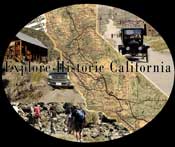When the Cornish miners, also known as "Cousin
Jacks", came to America to work in the mines, it appears
they brought more than their lunch pails of Cornish meat
pies, or pasties, with them. Elfin-like creatures, standing
anywhere from two to three feet tall, with great long
beards, extended arms, wrinkly crinkly faces, and extra
large sized heads came to the mines with them. Although
rarely seen by anyone, Tommyknockers are known by all of
who have ever worked in mines for any length of time.
Some say these mine fairies are actually the
souls of dead miners. There are those who say they are the
souls of the Jews who crucified Christ and were sent to work
in the tin mines as slaves. Some claim the "knockers" have
never been heard working on the Sabbath and other Jewish
days. At Christmas time, the sounds of their caroling
whispers through the tunnels. Regardless of origin, it is
agreed by all, that Tommyknockers can be welcome little
souls to have around.
Noted particularly for "knock-knock-knocking"
warnings of impending danger in the mines, Tommyknockers
have saved many a miner from certain disaster. They are also
said to be particularly fond of playing games. Missing
tools, drills, dynamite fuses, an occasional snuffed out
miner's candle, can often be accredited to the imps. An
unusual light in a tunnel that leads to a rich ore vein can
be a sign of their handy work as well. Watch out if you
leave your lunch around, in fact it's best to deliberately
leave a few bites just for the Tommyknockers, so you'll
still have some for yourself.
Those individuals familiar with such things say
it's advised to stay on the good side of the Tommyknockers.
Occasionally, a few ornery fellows have started a mine
collapse on their own with their incessant knocking. In
recent years, they've even taken to playing a few pranks
outside of the mines. More than a few people have reported
the Yellow Grade Road to the Cerro Gordo Mines being gated
at the start of the dirt road down by the shores of Owens
Lake. Having been up that way many, many, times myself,
including the weekend previous to the first reported
incident many years ago, I know there are no chains or
gates anywhere near that road. My only thought is that
perhaps the Tommyknockers got a little more brazen and
ventured out of one of the many open tunnels up there, to
play a prank on this poor fellow.
In addition to the Yellow Grade Road, the
Tommyknockers appear to like to play games on the other side
of the mountains as well. In the Death Valley region,
particularly around the town site of Skidoo, there have
been numerous reports that the Skidoo Stamp Mill was
missing. However, I have never had any trouble finding the
place, so I can only assume once again the elves of the hard
rock mines are at work for whatever reason.
Back in the late 1980’s some young friends and
I went through Burro Schmidt's tunnel in the El Paso
Mountains of the Western Mojave area. We noticed that
throughout the tunnel in nearly every little nook and
cranny, there were M & M candies. Now, it was Halloween
weekend, and we figured that (then) current tunnel owner,
Tonie Segar, was leaving trick or treat candy out for the
visitors. I now realize, that she was actually leaving
snacks for the Tommyknockers. Perhaps the Tommyknockers
were responsible for the obsession old William Henry had to
dig that tunnel to begin with.
Also in the Western Mojave area, near the towns
of Randsburg, Johannesburg and Red Mountain, the Atolia
Union head frame towers for all to see. One weekend we
looked down the shaft and were surprised to see a full size
pickup truck. Two weekends later, and it was gone.
Tommyknockers at work again?
On a visit to the Mesquite Canyon area, also
in the Western Mojave, a quick look at the mouth of a mine
on a hillside almost proved fateful for me. I managed the
climb up the steep slippery slope without a problem, but on
the descent, I fell and thankfully only slightly bruised my
tailbone. Now, which do you suppose it was? Were the
Tommyknockers responsible for tripping me, or did they
actually save me from slipping further down and really
injuring myself? A similar incident landed this author flat
on her face coming down from the cemetery at Cerro Gordo
last fall. The chipped tooth my smile now displays may be
more evidence of these little pranksters.
Should you ever wander around an old mine or an
old mining camp, in addition to all of the many safety
precautions one should take, it might be a good idea to
bring a gift for the Tommyknockers, so they will only treat
you well! I've known a few Tommyknockers that could be
bribed with Mrs. Fields Chocolate Chip Cookies, and
the elves at Cerro Gordo are particularly fond of miniature
triple chocolate Bundt cakes available at Trader Joe's
Markets. Regardless, never go around these areas without
having the appropriate bribes, be safe in whatever you do,
and remember, the mines in many areas are private property
and the Tommyknockers are hired by owners to keep you out.
